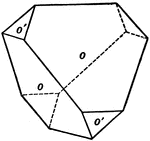Clipart tagged: ‘sulfide’

Acanthite
This figure, representing Acanthite, an orthrohombic crystal, shows a combination of the following forms:…
![This figure represents a crystal of iron pyrite showing representatives of all the forms of the isometric system except the rhombic dodecahedron: ∞O∞ {100} (P); O, {111} (d); [∞O2/2], π{102} (e); [4O2/2], π{214} (s); 2O2, {211} (o); and 3O, {133} (t). It is shortened in the direction of one of the principal axes, which, together with the fact that only two of the three faces belonging to the forms s, o, and t are developed in each octant, gives to it a decidedly orthorhombic habit.](https://etc.usf.edu/clipart/86800/86858/86858_crystal-of-iron-pyrite-showing-representatives_mth.gif)
Crystal of Iron Pyrite Showing Representatives of All the Forms of the Isometric System
This figure represents a crystal of iron pyrite showing representatives of all the forms of the isometric…

Cube of Iron Pyrite
Cubes of Iron Pyrites frequently show a striation of their planes in one direction, which is perpendicular…
![It has been observed that the pentagonal dodecahedron, [∞o2/2], π {201}, on pyrite may have but six of its twelve planes developed in such a manner a to produce an apparent rhombohedron.](https://etc.usf.edu/clipart/86800/86856/86856_pyrite_mth.gif)
Pyrite
It has been observed that the pentagonal dodecahedron, [∞o2/2], π {201}, on pyrite may have but six…

Sphenoidal Crystallization
An example of sphenoidal crystallization is Iron-Copper-Sulfide (FeS_2_Cu), also known as chalcopyrite.